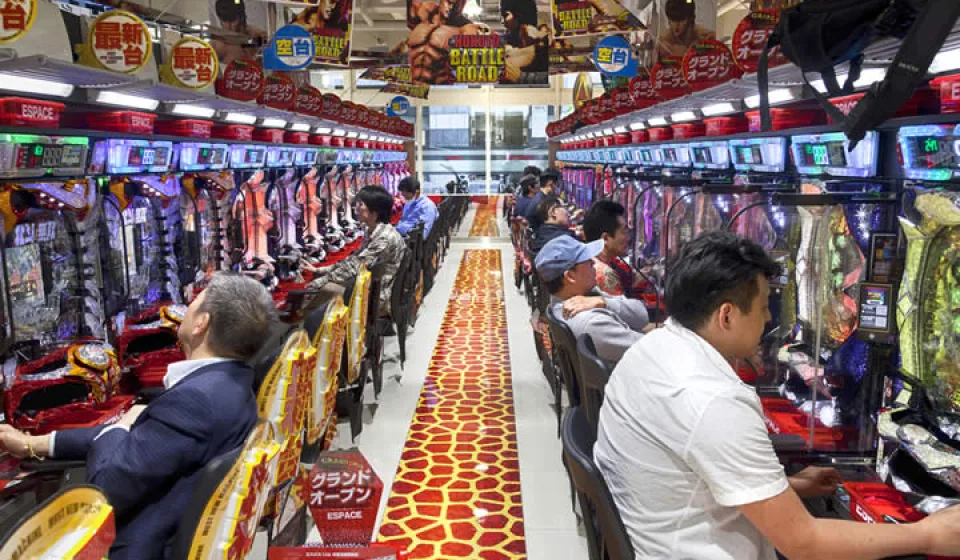The pachinko industry, a uniquely Japanese blend of pinball and slot gaming, has long been a cornerstone of both cultural entertainment and economic activity in Japan. Known for its interactive gameplay, themed machines, and social appeal, pachinko halls have attracted millions of players for decades. However, recent trends point to a troubling Japan pachinko market decline, signaling a shift in the nation’s leisure landscape. Factors such as stricter regulations, changing consumer preferences, and the rapid rise of online gaming platforms are reshaping the industry. As traditional pachinko halls struggle to maintain their player base, industry experts are closely monitoring how operators adapt to these challenges and whether innovation can reverse the downward trend.
Pachinko, a unique blend of pinball and slot machines, is a popular pastime in Japan. Players launch steel balls into a vertical playing field, aiming for a jackpot that rewards them with more balls. These balls can then be exchanged for prizes or tokens, making it a thrilling gaming experience. Key features of Pachinko include:
- Highly interactive gameplay
- Various themes and designs
- Potential for lucrative wins
For decades, Pachinko has been an integral part of Japanese culture. It serves not just as entertainment, but also as a social activity where friends and families gather. This gaming phenomenon reflects the values of perseverance and luck in Japanese society. Some notable cultural aspects include:
- Community bonding
- Long-standing tradition
- Unique entertainment value
Economic Impact of Pachinko on the Japanese Market
The Pachinko industry has significantly contributed to Japan’s economy, generating billions in revenue each year. However, recent trends indicate a worrying Japan pachinko market decline. Factors influencing this decline include:
- Shift in consumer preferences
- Enhanced regulations
- Rise of online gaming alternatives
Despite facing challenges, the Pachinko sector remains a crucial element of Japan’s entertainment landscape, and its evolution will be noteworthy as it adapts to modern market demands.
Current Trends in the Pachinko Industry
Recent Declines in Player Numbers
The Japan pachinko market has been experiencing a notable decline in player participation in recent years. Factors contributing to this dwindling interest include:
- Increased competition from online gaming platforms
- Changes in consumer entertainment preferences
- Regulations tightening around gaming establishments
Challenges Faced by Pachinko Operators
Pachinko operators are grappling with several obstacles that threaten their profitability:
- Rising operational costs
- Restrictive laws limiting gaming hours and prizes
- Adaptation to a tech-savvy audience who prefer digital gaming experiences
Changes in Player Demographics
There’s a shift in the profiles of individuals engaging with pachinko. Recent trends indicate:
- A younger demographic is turning away from traditional pachinko halls
- Increased female participation is noted, but overall numbers are falling
- Players are now seeking more immersive and interactive experiences
As the industry adapts to these shifts, understanding the underlying reasons for the Japan pachinko market decline is crucial for operators aiming to revitalize their business model and attract new players.
Factors Contributing to the Decline
Regulatory Changes and Their Effects
Recent regulatory modifications have had a significant impact on the Japan pachinko market decline. Key changes include:
- Increased taxation on operators, leading to higher costs and lower profitability.
- Stricter laws surrounding gambling, causing a decrease in player engagement.
- Enhanced compliance requirements that strain smaller establishments, pushing them out of the market.
Shifts in Entertainment Preferences
Consumer tastes are evolving, contributing to the Japan pachinko market decline. Notable trends include:
- Growing popularity of mobile gaming and online casinos, capturing the attention of younger audiences
- Increased demand for immersive experiences and video game-like content in leisure activities.
- Declining interest in traditional forms of entertainment, as customers seek novelty and convenience.
Economic Factors Impacting Player Spending
The economic landscape also plays a crucial role in the Japan pachinko market decline. Some economic influences are:
- Fluctuations in disposable income, limiting players’ ability to spend
- Concerns about economic stability, prompting consumers to be more cautious with their spending habits.
- Rising living costs affecting discretionary spending, including entertainment budgets
Understanding these contributing factors is essential for assessing the current challenges faced by the pachinko industry
Operator Responses to the Decline
Innovations and Adaptations in Pachinko Halls
The Japan pachinko market decline has spurred operators to rethink their strategies. To remain competitive, many have embraced innovation and adaptation:
- Introducing themed machines that resonate with younger audiences.
- Implementing advanced technologies such as augmented reality to enhance gaming experiences.
- Enhancing the ambiance with modern designs and comfortable seating to attract new players.
Marketing Strategies to Attract Younger Players
In light of the pachinko market decline, effective marketing is crucial. Operators have launched several strategies aimed at drawing in a younger demographic:
- Engaging social media campaigns showcasing exciting gameplay and rewards.
- Hosting tournaments and special events to build community engagement.
- Offering incentives like loyalty programs that appeal to younger players.
Partnerships and Collaborations within the Industry
As the industry shifts, collaborations have become key to navigating the Japan pachinko market decline. By joining forces, operators can maximize their reach:
- Partnering with popular brands and franchises to introduce co-branded machines.
- Collaborating with tech companies to innovate gaming solutions and improve operational efficiency.
- Creating alliances with entertainment entities to host larger events and promotions.
International Comparisons
How Pachinko Compares to Other Forms of Entertainment Globally
Apacaff | The Japan pachinko market decline offers an intriguing lens through which to examine global entertainment trends. Unlike traditional gaming or slot machines seen in other cultures, pachinko is a unique fusion of pinball and gambling.
- Pachinko parlors offer a social atmosphere similar to bars and arcades.
- In contrast, Western gaming centers often emphasize video games and community events.
- The player experience in pachinko is heavily influenced by Japan’s rich cultural history, setting it apart from other forms of gaming worldwide.
Insights from Other Countries with Similar Gaming Industries
Exploring Japan pachinko market decline alongside similar industries worldwide reveals significant trends:
| Country | Gaming Type | Market Trends |
|---|---|---|
| USA | Casino Gaming | Increasing popularity of online gaming |
| China | Lottery Games | Heavy restrictions on gambling |
| South Korea | PC Bangs | Emerging esports scene |
The Role of Globalization in the Pachinko Market
Globalization has significantly impacted the Japan pachinko market decline, as western influences reshape consumer preferences:
- Increased exposure to online gambling options has diverted traditional players.
- International gaming brands are competing for attention, offering diverse formats that attract younger audiences.
- It’s essential for the Japanese pachinko industry to adapt in order to thrive in this evolving landscape.
Future Outlook for the Pachinko Industry
Predictions for Player Engagement
As the Japan pachinko market decline continues to impact player participation, industry analysts forecast a gradual revitalization in player engagement. Key predictions include:
- Enhanced gaming experiences through immersive technologies
- Targeted marketing strategies to appeal to younger demographics
- Integration of social features and competitive elements in gameplay
Potential for Revival and Growth
Despite the ongoing decline, there remains a glimmer of hope for the pachinko industry. Potential pathways for revival include:
- Government regulations easing restrictions on operations
- Collaboration with international gaming firms to introduce new concepts
- Investment into modernization of existing pachinko parlors
Opportunities for Innovation in Technology
The push for technological advancements presents unique opportunities within the pachinko sector. Innovations that could reshape the landscape are:
- Augmented reality (AR) to enhance player immersion
- Use of blockchain for secure transactions and loyalty rewards
- Development of mobile apps to connect with a broader audience
In summary, while the Japan pachinko market decline poses challenges, opportunities for growth and innovation abound. The future may just hold the key to restoring the industry’s former glory.
Conclusion
Summary of Challenges Facing the Industry
The Japan pachinko market has been grappling with a range of obstacles that have hindered its growth. Some of the primary challenges include:
- Increased competition from other gaming forms, such as online gambling and video games.
- Stricter regulations impacting operational practices and revenues.
- Changing consumer preferences with younger generations opting for alternative entertainment options.
- Economic factors, including rising costs and stagnant wages impacting disposable income for leisure activities.
The Need for Adaptive Strategies to Survive
To navigate the decline in the Japan pachinko market, operators must adopt innovative strategies that resonate with modern audiences. Key approaches may involve:
- Embracing technological advancements, such as integrating mobile gaming experiences.
- Revamping the pachinko hall environment to enhance customer experience and engagement.
- Developing promotional campaigns that target young adults, highlighting the social aspects of pachinko gaming.
- Diversifying offerings by introducing complementary services and games that attract a broader demographic.
Final Thoughts on the Pachinko Industry’s Future
The future of the pachinko industry in Japan is uncertain, yet it holds potential for revival if proactive measures are embraced. By recognizing the underlying issues and seeking adaptive solutions, the market can re-establish its foothold. Industry players must remain vigilant and responsive to shifting trends to foster resilience amidst the ongoing decline.
References
Sources of Industry Data and Analysis
Understanding the Japan pachinko market decline necessitates examining reliable sources. Here are some reputable references:
- Japan Gambling Study Report – A comprehensive analysis of gambling trends in Japan.
- Market Research APIs – Access real-time data and insights about the pachinko industry.
- Industry Journals – Publishing peer-reviewed articles relevant to the gambling landscape in Japan.
Further Reading on Pachinko and Its Cultural Impact
If you want to delve deeper into the significance of pachinko in Japanese society, these resources are invaluable:
- Pachinko: A Cultural Phenomenon – An exploration of how pachinko has shaped Japanese entertainment.
- The Evolution of Pachinko – A historical perspective on the game’s development over the decades.
- Gaming and Society – Studies on how gaming, including pachinko, affects social dynamics in Japan.
Expert Opinions and Industry Commentary
Opinions from industry experts provide unique insights into the current trends and challenges faced by the pachinko sector:
- Market Analysts – Insights on factors contributing to the Japan pachinko market decline.
- Economic Experts – Commentary on the financial implications for pachinko businesses moving forward.
- Player Perspectives – Testimonials and views from avid pachinko players.














